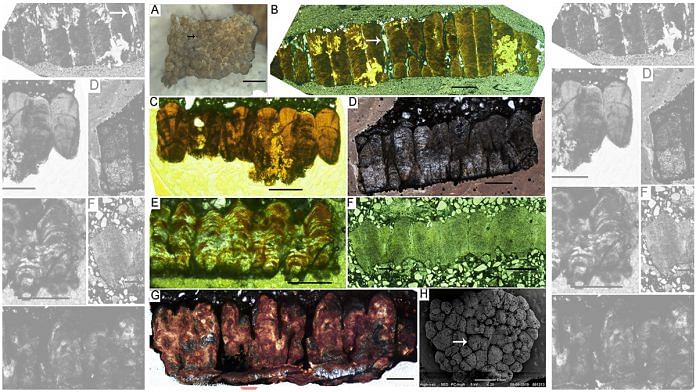New Delhi: A fossilised hatchery of more than 250 dinosaur eggs discovered in Madhya Pradesh’s Dhar district has revealed exciting new details about the massive titanosaurs that once roamed the Narmada Valley, just before they went extinct.
The study, published in the peer-reviewed scientific journal PLOS One Wednesday, was carried out by a team of researchers from Delhi University (DU) and the Indian Institute of Science Education and Research (IISER) in Bhopal. It reveals new details not only about the lives of titanosaurs in the Indian subcontinent, but also about the features of the surrounding landscape.
During their field work, the researchers uncovered 92 nesting sites containing a total of 256 fossil eggs belonging to titanosaurs — among the largest dinosaurs to have roamed the planet — from the Lameta Formation in the Narmada Valley.
The Lameta Formation is a sedimentary geological belt in MP, Gujarat, and Maharashtra. It is known to yield fossils dating from the Late Cretaceous Period, extending from about 101 to 66 million years ago.
The research team carried out detailed field investigations in December 2017, January 2018 and March 2020 in the Dhar district of Madhya Pradesh. Data was collected from five localities: Akhada, Dholiya Raipuriya, Jhabua, Jamniapura and Padlya.
The researchers had to overcome several challenges, including hostile villagers in Akhada who did not let the team complete their field work.
A total of 92 clutches of eggs were detected from the five localities. The team identified six different egg-species — known as oospecies — suggesting that the area had a higher diversity of titanosaurs than what has so far been estimated from the skeletal remains found in this region.
“Quantitatively, this is a huge cache of eggs. From just five areas, we have found 92 nests containing 256 egg remains,” Harsha Dhiman, a researcher at the University of Delhi, told ThePrint. The research was part of Dhiman’s PhD work.

Details of dinosaur reproductive habits can be difficult to determine. These fossil nests provide a wealth of data about some of the largest dinosaurs in history, and they come from a time shortly before the age of dinosaurs came to an end about 65 million years ago.
Also read: ‘Is it a bird? Is it a dinosaur? It’s both. 120 mn-yr-old fossil sheds light on how birds evolved’
‘One of the largest dinosaur hatcheries in world’
Based on the layout of the nests, Dhiman inferred that the dinosaurs buried their eggs in shallow pits, like modern-day crocodiles.
In all, the team was able to document three different types of clutches that were found in the area.
The first, and the most prominent ones, were the circular type, in which about four to six eggs were randomly distributed in a pit with ample space between them.
Such clutches have previously been identified from Spain, Argentina and France, the authors wrote in their report.
The second clutch variety is called a combination type, with the eggs more tightly grouped in shallower pits. The third was a linear type, in which eggs lie close to each other in a line.
The presence of many nests in the same area suggests these dinosaurs exhibited colonial nesting behaviour like many modern birds.
The researchers noted that the close spacing of the nests left little room for adult dinosaurs. Along with this, they did not find fossilised remains of adults or juveniles in the area. Both these findings support the idea that adults left the hatchlings to fend for themselves, which is a behaviour observed in some amphibians.
It is also possible that the bones of dinosaurs remained unexposed and could be discovered some day, the researchers wrote in their study.
The researchers even found eggs with a missing upper surface from where the hatchling may have emerged.
Certain pathologies found in the eggs, such as a rare case of an “egg-in-egg”, indicate that titanosaur sauropods had a reproductive physiology that parallels that of birds. They also possibly laid their eggs in a sequential manner as seen in modern birds.
On the basis of further studies conducted on the rocks — and some eggs that seemed to have got buried too deep to ever hatch — the researchers postulate that the area may have had a meandering river in the past.
Some of the eggs were also laid in sediments that look like they could once have been small ponds or lakes. Occasionally, some eggs would get completely submerged in these waterbodies, preventing them from hatching.
Dhiman’s PhD guide and leader of the research team, Guntupalli V.R. Prasad, said: “Together with dinosaur nests from Jabalpur in the upper Narmada Valley in the east and those from Balasinor (Gujarat) in the west, the new nesting sites from Dhar district in Madhya Pradesh, covering an east-west stretch of about 1,000 km, constitute one of the largest dinosaur hatcheries in the world.”
Dhiman said she hopes to find bones or teeth of adult dinosaurs in future field studies since these would allow them to identify the dinosaur species that possibly laid these eggs.
“Since this was my PhD work, I did not have resources to carry out CT scans of the whole eggs,” Dhiman said. In future, she hopes that CT scans of the eggs will help learn more about the titanosaurs in India.
(Edited by Nida Fatima Siddiqui)
Also Read: Scientists find fish that stress eat their own babies & spot a black hole gobbling up a star



